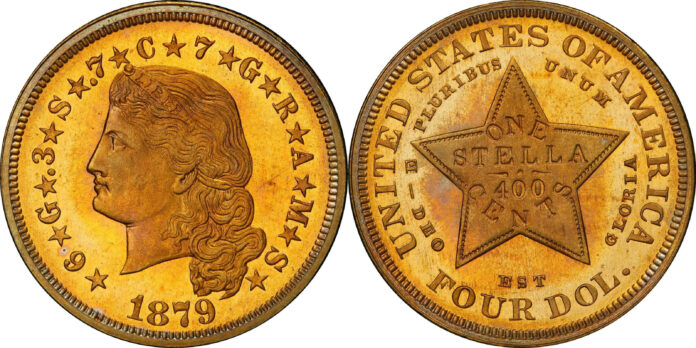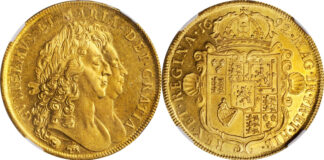Brent Pogue Collection Surpasses Total of 131 Million Dollars
Against a backdrop of economic uncertainty and negative indicators, rare coins continued to shine at the Stack’s Bowers Galleries March 2020 Auction in California. Nearly three years after Part V of the D. Brent Pogue Collection hit the market, the most valuable coin collection ever sold cemented its grip on the record books with more than $15 million in additional sales. To date, the Pogue Collection has realized $122,012,480 for the coins and $131,298,560 total, including the paper money collection sold on March 19. Originally scheduled to be held in Baltimore, the auction was moved to the Stack’s Bowers Galleries headquarters in Santa Ana following the cancellation of all public events in the state of Maryland and was hold on March 19-20, 2020. With most bidders participating online, the 420 lots realized 104% of their presale high estimates, which were determined well before recent economic difficulties. (All prices include the buyer’s fee.)
While the Pogue Collection is renowned for its superb quality pre-1834 coins and legendary rarities, the Pogue VII sale featured collections that showed the remarkable breadth and depth of the Pogue holdings. While red-letter issues like the Berg-Garrett 1804 dollar and the finest known 1854-S half eagle reached seven-figure heights, the superbly preserved and spectacularly toned Pogue Washington quarter set brought multiples of estimate, Barber quarters reached dizzying heights, and even Eisenhower and Susan B. Anthony dollars achieved exceptional prices. Collectors also competed over the Pogue “lowball” set, with the world’s worst examples of some types bringing multiples of what well-preserved examples regularly bring.
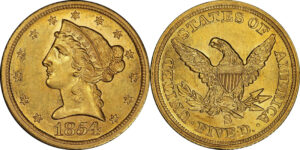
The two leading lots were among the most famous rarities in the entire realm of United States coinage. Leading all sales was the finest known example of the legendary 1854-S half eagle, the first $5 gold coin struck in the San Francisco Mint. Pedigreed to the Eliasberg Collection, the PCGS AU-58+ Pogue coin is the best example of the three confirmed to still exist. It realized $1.92 million after 38 years off the market. An example of the “King of American Coins,” the Berg-Garrett Class III 1804 dollar, brought $1.44 million. It was graded Proof-55 (PCGS).
At $408,000, the famous “Little Princess” 1841 Proof quarter eagle from the Pogue Collection set a new world record for the type. Pedigreed to the Eliasberg and Bass collections, the Pogue specimen is graded Proof-64 CAM (PCGS) and is considered the finest in private hands.
Also setting a new world record, the finest known example of the key date 1878-S half dollar brought $288,000. Graded Proof-66 (PCGS-CAC), its long provenance includes several Stack’s and Bowers and Merena auctions dating back to 1961, led by such legendary names as R.E. Cox (1962), Fairfield (1977), Robison (1982), and Quellar (2002).
Another world record was set by the finest known 1854-S quarter eagle, formerly in the F.C.C. Boyd and Harry W. Bass, Jr. collections. Graded AU-50 (PCGS), the low-mintage rarity brought $384,000, surpassing a 15-year old record for the date.
Among other lots, a MS-66 RB (PCGS) example of the key date 1796 With Pole half cent brought $336,000. A Gem Proof 1833 dime rarity with a provenance to the 1890 Cleneay sale, graded Proof-66 (PCGS), brought $108,000, far surpassing pre-sale estimates. Despite being plentiful in low grades, the finest certified 1853 Arrows and Rays quarter is elusive enough in MS-67 (PCGS) to merit a final price of $72,000, more than 50% higher than initial estimates. The Eliasberg-Pogue 1907-S quarter, graded MS-68 (PCGS), blew by its $20,000-25,000 estimate, selling for a record $72,000. Two seated dollars brought six-figure sums, including the 1863 in MS-67 (PCGS) at $108,000 and the 1866 in MS-66+ (PCGS) at $132,000.
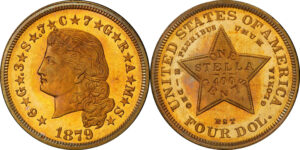
Highlights among gold coins included the superb 1855 Type II gold dollar, perhaps finest of the short-lived design type at MS-67+ (PCGS), which sold for $120,000. A Type II gold dollar dated 1854, graded MS-66+ (PCGS), far surpassed expectations at $87,000. The 1879 Flowing Hair Stella $4, graded Proof-66 CAM (PCGS), brought $264,000. A pair of 1820 half eagles, each graded MS-65+ (PCGS), yielded $174,000 and $180,000. The stunning Norweb-Bass-Pogue 1845-D half eagle in PCGS MS-65, the finest known survivor of the issue, far surpassed estimates at $96,000. The finest surviving 1911-S half eagle, acquired by John Jay Pittman at the legendary 1954 King Farouk sale, was graded MS-66 (PCGS) and brought a very strong $90,000. A pair of Liberty Head eagles each passed the $200,000 barrier: an 1848-O in PCGS MS-66 ($240,000) and an 1852 in PCGS MS-66+ ($288,000). A 1907 Indian $10, Wire Rim, Periods, brought $240,000 in PCGS MS-67, while a Rounded Rim, Periods example of the date in the same grade brought $576,000. A remarkable Gem MS-68 (PCGS) 1908-D Indian $10, the Clapp-Eliasberg coin, brought $204,000.
Superb Gem double eagles starred among later lots. A pair of MCMVII (1907) High Relief $20s each soared to six-figure results: a Wire Rim in MS-67+ (PCGS) at $222,000 and a Flat Rim in MS-68+ (PCGS) at $456,000. Liberty Head double eagle highlights began with San Francisco Mint issues: an 1854-S in MS-65 (PCGS) brought $132,000 and an 1857-S from the SS Central America in MS-67 (PCGS) sold for $96,000. A MS-67 (PCGS) 1875-S $20, considered the single finest known Type II Liberty double eagle, brought $432,000. A remarkable Gem 1869 $20, MS-66 (PCGS), sold for $204,000. The finest graded 1909/8 Saint-Gaudens $20, MS-66+ (PCGS), sold well at $108,000, while the Morse-Duckor-Pogue 1927-S Saint-Gaudens $20, the single finest graded by PCGS at MS-67, brought $264,000. The Panama-Pacific $50s surpassed estimates. Both the octagonal (at $138,000) and the round (at $192,000) were graded MS-65 by PCGS.
The Proof-65 (PCGS) 1879 Schoolgirl dollar, Judd-1608, led all patterns at $144,000. A Morgan pattern 1877 half dollar, Judd-1520, realized $96,000 in Proof-65 (PCGS) and a beautiful Judd-1698 “Shield Earring” quarter dollar pattern of 1882, graded Proof-65+ (PCGS), brought $78,000. A modern pattern, the Specimen-67+ (PCGS) 1964 Kennedy half dollar with SMS finish, was bid to $60,000.
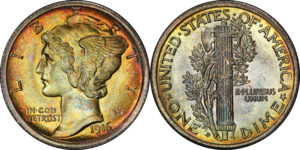
Key date coins of all series performed well. The Eliasberg 1909-S V.D.B. cent, PCGS MS-66 RB, more than doubled high estimate at $8,400, and a Gem 1955 Doubled Die in MS-65 RB (PCGS) also more than doubled its estimates with a $32,400 sale price. An MS-67 FB (PCGS) 1916-D Mercury dime, tied for finest certified, surpassed expectations at $204,000. The MS-66 1896-S quarter, tied for finest certified, brought $96,000 and the MS-67+ (PCGS) 1901-S Barber quarter realized $180,000. The MS-65 (PCGS) 1918/7-D overdate Standing Liberty quarter blew by estimates, selling for $90,000. The 1919-D quarter is a major condition rarity in superb gem grades, pushing the Pogue MS-66+ FH (PCGS) to a final price of $114,000. A beautiful 1932-S quarter in PCGS MS-66 brought $43,200 against its $20,000-25,000 estimate.
The PCGS-graded Pogue Washington quarter set won accolades for both superb grades and spectacular toning. Despite most coins being estimated in the few hundreds to few thousands of dollars, collectors bid the coins well beyond those levels. Some of the biggest differentials between estimate and final price included the MS-67 1934 ($6,000 vs. $400-500), MS-67+ 1938-S ($4,080 vs. $600-750), MS-66 1939 ($600 vs. $50-75), MS-67 1944 ($9,000 vs. $250-300), MS-67 1945-S ($7,200 vs. $300-350), MS-67+ 1948 ($7,200 vs. $600-750), MS-67 1949-D ($2,880 vs. $200-250), MS-67+ 1950-D ($5,280 vs. $250-300), MS-67 1950-S ($2,880 vs. $40-50), MS-67+ 1954-D ($6,600 vs. $550-700), and an MS-67 1963-D ($8,400 vs. 500-600).
Washington quarters weren’t the only coins that brought remarkable premiums for superb toning. A MS-67+ FS (PCGS) 1943-D nickel brought $6,600 (estimate: $100-300), a MS-67 FB (PCGS) 1916 Mercury dime with a gold CAC label brought $9,600 (estimate $700-800), a MS-68 (PCGS) 1892 Barber quarter brought $25,200 (estimate: $8,000-10,000), a MS-66 (PCGS) 1917-D quarter sold for $12,000 (estimate: $1,500-2,000), and a very dramatically toned MS-67 (PCGS) 1920-S quarter brought a remarkable $40,800 on a $5,000-6,000 estimate. Every two-cent and three-cent piece in the sale surpassed pre-sale estimates as well.
High grade modern coins with superb toning also shined, led by a MS-66 (PCGS) 1976-D Eisenhower dollar at $4,080 (vs. a $50-100 estimate) and a MS-67 (PCGS) 1981-D Susan B. Anthony dollar at $2,640 (vs. a $200-300 estimate).
The opposite of high grade coins – Pogue’s “low-ball” set – also saw frenzied bidding, led by a Poor-1 (PCGS) 1938 New Rochelle commemorative half dollar, a condition rarity that brought $4,080.
A small group of medals also performed well, including the Pogue silver Libertas Americana medal in PCGS MS-63 at $144,000, and a bronze Libertas Americana medal in PCGS MS-64 BN at $33,600. The Boyd-Ford Washington-Franklin Peace of 1783 Baker-58 medal in silver, graded Specimen-64 by PCGS, brought $28,800. A copy of Henry Tuckerman’s The Character and Portraits of Washington bound with a gold Washington funeral medal shell brought $66,000.

Part VI: More Than $9.2 Million for United States Paper Money
Stack’s Bowers Galleries’ remarkable offering of the D. Brent Pogue Collection Part VI – Masterpieces of United States Paper Money realized over $9.2 million during the firm’s March 2020 Auction, held at their Santa Ana headquarters Thursday, March 19. The prices realized for the 230 lots averaged more than $40,000 each and 27 notes brought six-figure results.
The marvelous Pogue collection of United States paper money was assembled over many years and featured a number of notes that are the finest examples graded for their type. Particular emphasis was also placed on highly desirable serial number 1 notes and rare “Star” replacement notes.
Lot 6063 presented an incredible Fr.167a 1863 $100 Legal Tender Note graded Gem Uncirculated 65 EPQ that brought the highest price of the sale realizing $432,000. It is the finest known example of the ever-popular “Spread Eagle” design, which was the nation’s first $100 Legal Tender design type.
Two famed Series of 1869 “Rainbow” notes brought prices well into the six-figure range. A Fr.151 $50 Legal Tender Note graded Gem Uncirculated 65 EPQ in lot 6058 garnered $300,000, while lot 6064, a Fr.168 $100 Legal Tender Note, also graded Gem Uncirculated 65 EPQ, sold for $312,000.
Headlining the remarkable offering of serial number 1 notes in the collection was a Fr.1074a 1914 $100 Red Seal Federal Reserve Note from the Philadelphia district graded Choice Uncirculated 64 by PMG. The note, offered in lot 6131, is one of only five serial number 1 examples known for the type and realized $156,000 in Thursday night’s session.
The finest known Fr.282* 1923 $5 “Porthole” Silver Certificate Star Note, graded Superb Gem Uncirculated 68 EPQ by PMG, was sold for $43,200 (lot 6087) and was the highest grossing replacement note in the auction.
All prices include the buyer’s fee. For complete prices realized for The D. Brent Pogue Collection Part VI and VII, as well as more results from the Stack’s Bowers Galleries March 2020 auction, visit the Auction Archive at the Stack’s Bowers website.
For more information visit the Stack’s Bowers website.




